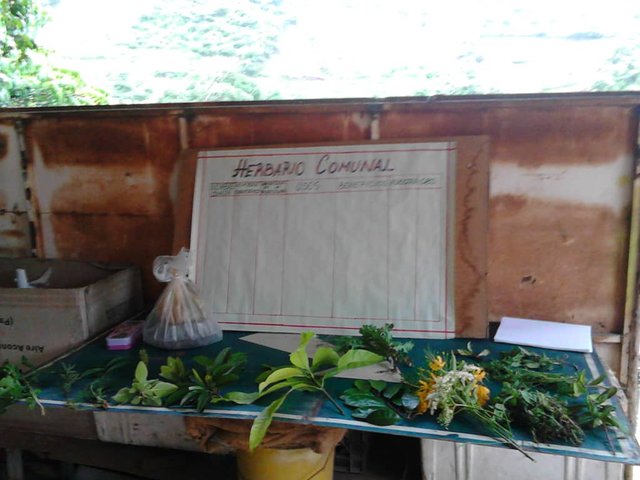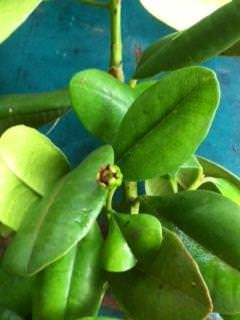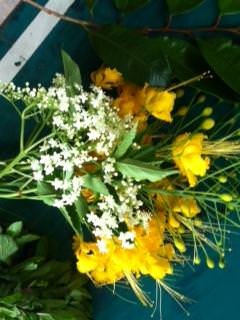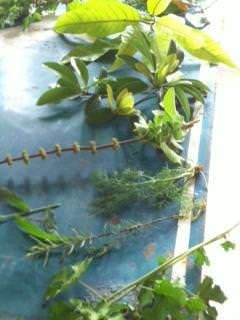CONSTRUCCIÓN DE UN HERBARIO COMUNAL - CONSTRUCTION OF A COMMUNAL HERBAL

Parte 2
Probablemente con el artículo de hoy no concluya sobre el tema iniciado en https://steemit.com/entropia/@valquerales/simplementeherbario-simplyherbal-ot264sdki7# por cuanto no pensé que había tal cantidad de plantas medicinales y aromáticas en la zona donde habito. Es impresionante, así que voy a comentarles primeramente que fue una mañana y parte de la tarde muy diferente al habitual día a día.

Fuimos recibidos en su casa, ubicada en la población de Río Claro por el buen amigo Gustavo Giménez, artesano, hombre curioso y creativo, por doquier se observan piedras raras, tallas de madera, escultura con partes mecánicas, mesas y en las columnas figuras de flores que habilidosamente se ingenia Gustavo para dejar talladas en el cemento. Las amigas habían preparado platos de comida partiendo de sencillos ingredientes pero a la altura de los mejores chef de cocina, se idearon con lentejas un plato salado una torta con vegetales; luego se degusto unas torticas de plátano verde con aliños, y como broche de oro torta de auyama y tartaletas con base de yuca, rellenas con plátano dulce y queso rallado, en cuanto a las bebidas, como hacia frio, infusión de malojillo, poleo con limón, y luego en la tarde cuando ya estaba cálida la temperatura sangría fría, y aclaro que no es la tradicional sangría de vino. Los aliños provenían del patio de cada una, por ejemplo, la albahaca, el cilantro fraile o culantro y el cebollín, entre otros. Nunca pensé que plantas que habitualmente veo en el patio, tengan propiedades medicinales y lo más curioso que uno siempre las arranca por ser monte, ahora con muchísimo respeto en el patio de la casa van a ser tratadas y reubicadas, definitivamente uno tiene dolencias porque quiere y no porque las puede tratar o prevenir.

Una de estas plantas que por lo general las personas maltratan porque se resiste a que la acaben es la conocida en esta zona como Bledo, Bleo o Pira. Esta planta que puede alcanzar una altura de hasta un metro existe en nuestros patios en dos colores, la verde con capullo verde-amarillo cuyo contenido es altamente nutricional y la roja con el capucho rojo tinto. Las personas en el campo la preparan en sopas, como si fuera un apio España, en ensaladas (sin cocción alguna), la licuan para haber bebedizos, o espolvorean el capullo a los huevos al freírlos. Realmente no tiene un sabor específico al combinarlo con otros alimentos pero si se bebe licuado al natural, se siente el amargoso de la planta. Se usa básicamente porque es un oxigenante natural, y lo recomiendan hervir para beberlo en lugar de agua. Comentan las amigas que lo utilizan que también el Bledo aporta calcio a nuestro organismo, tomado en infusión el Bledo rojo aumenta la hemoglobina y sus semillas tostadas se toman con leche, pero además es un buen alimento alternativo para quienes crían gallinas, cochinos y en general animales de granja. Este es un ejemplo de las diferentes plantas que aunque son de apariencia sencilla, algunas de aspecto poco atractivo, hay que tenerles respeto porque cada una nos permite aliviar dolores musculares, inflamaciones del hígado, expulsar parásitos, combatir dolores en los huesos, limpiar los riñones, parar derrames menstruales, bajar fiebre, digestivo, caída de cabello, antiinflamatorio, antiespasmódico, antisépticos incluso hasta para evitar piojos, garrapatas y pulgas en los animales domésticos, entre otros muchos usos. Se pudo trabajar un total de 34 plantas, pero obviamente faltaron muchísimas más. Así pues como Roma no se construyó en un día, continuaremos reuniendo más información.

Después de esta bella experiencia decidimos que teníamos que continuar con la construcción del herbario, pero ahora con la combinación de plantas, el para que se utilizan y el cómo se preparan. Tenemos mucha tela que cortar. Considero que este es un trabajo que día a día puede crecer con el concurso de todas aquellas personas que deseen hacerlo, se sumen con sus vecinos, amigos, parientes, a realizar esta tarea que es de gran utilidad, cuando tengamos preparado nuestro Herbario Comunal estaremos haciendo su difusión porque consideramos que el conocimiento debe ser compartido, más cuando se están buscando alternativas que nos permitan no solo contemplando la naturaleza, sino entendiendo que somos una parte de ella. Espero sigan disfrutando de los siguientes artículos en torno a este interesante tema.

CONSTRUCTION OF A COMMUNAL HERBAL
Part 2
Probably with the article today do not conclude on the topic started at https://steemit.com/entropia/@valquerales/simplementeherbario-simplyherbal-ot264sdki7# because I did not think there were such a large number of medicinal and aromatic plants in the area where I live. It's impressive, so I'm going to tell you first that it was one morning and part of the afternoon very different from the usual day to day. We were welcomed at his home, located in the town of Río Claro by the good friend Gustavo Giménez, craftsman, curious and creative man, everywhere we see rare stones, wood carvings, sculpture with mechanical parts, tables and in the columns figures of flowers that Gustavo ingeniously managed to leave carved in the cement.
The friends had prepared food based on simple ingredients, but at the height of the best chef, a salty dish with vegetables was devised with lentils; Then you can taste some green banana tortillas with dressings, and as a flourish cake of auyama or pumpkin and tartlets with yucca base, stuffed with sweet banana and grated cheese, as for drinks, as towards cold, infusion of malojillo, pennyroyal with lemon, and then in the afternoon when it was already warm cold sangria temperature, and clarified that it is not the traditional wine sangria. The dressings came from the yard of each one, for example, the basil, the coriander friar or coriander and the scallion, among others. I never thought that plants that I usually see in the patio, have medicinal properties and the most curious thing that one always starts them for being a mount, now with a lot of respect in the patio of the house they are going to be treated and relocated, one definitely has ailments because he wants and not because he can treat or prevent them.

One of these plants that people usually mistreat because it resists the end is known in this area as Bledo, Bleo or Pira. This plant that can reach a height of up to one meter exists in our courtyards in two colors, green with green-yellow cocoon whose content is highly nutritional and red with red red hood. The people in the field prepare it in soups, as if it were a celery Spain, in salads (without any cooking), liquefy it for beverages, or sprinkle the cocoon to the eggs when frying them. It does not really have a specific flavor when combined with other foods but if you drink liquefied in nature, you feel the bitterness of the plant. It is basically used because it is a natural oxygenating agent, and it is recommended to boil it to drink instead of water. The friends who use it also comment that the Bledo brings calcium to our body, taken in infusion the Red Bledo increases the hemoglobin and its toasted seeds are taken with milk, but it is also a good alternative food for those who raise chickens, pigs and in general farm animals. This is an example of the different plants that although they are simple in appearance, some have an unattractive appearance, we must respect them because each one allows us to alleviate muscular pains, inflammations of the liver, expel parasites, fight bone pains, clean the kidneys, stop menstrual spills, lower fever, digestive, hair loss, anti-inflammatory, antispasmodic, antiseptic even to avoid lice, ticks and fleas in pets, among many other uses. A total of 34 plants could be worked, but obviously many more were missing. So as Rome was not built in a day, we will continue to gather more information.

After this beautiful experience we decided that we had to continue with the construction of the herbarium, but now with the combination of plants, what they are used for and how they are prepared. We have a lot of fabric to cut. I believe that this is a job that every day can grow with the help of all those who wish to do so, join with their neighbors, friends, relatives, to perform this task that is very useful, when we have prepared our Community Herbarium we will be making its diffusion because we believe that knowledge should be shared, more when we are looking for alternatives that allow us not only contemplating nature, but understanding that we are a part of it. I hope you continue to enjoy the following articles on this interesting topic.

Posted from my blog with SteemPress : https://cosasdevalen.000webhostapp.com/2018/07/construccion-de-un-herbario-comunal-construction-of-a-communal-herbal
Congratulations! This post has been upvoted from the communal account, @minnowsupport, by Valquerales from the Minnow Support Project. It's a witness project run by aggroed, ausbitbank, teamsteem, theprophet0, someguy123, neoxian, followbtcnews, and netuoso. The goal is to help Steemit grow by supporting Minnows. Please find us at the Peace, Abundance, and Liberty Network (PALnet) Discord Channel. It's a completely public and open space to all members of the Steemit community who voluntarily choose to be there.
If you would like to delegate to the Minnow Support Project you can do so by clicking on the following links: 50SP, 100SP, 250SP, 500SP, 1000SP, 5000SP.
Be sure to leave at least 50SP undelegated on your account.
Este post fue elegido para ser votado por THEUNION.

Puedes unirte en nuestro canal de DISCORD
Gracias @theunion por la deferencia. Voy a visitarlos.